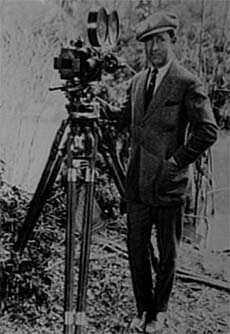Arthur Edeson
Arthur Edeson ( born October 24, 1891 in New York City, New York, † February 14, 1970 in Agoura Hills, California ) was an American cinematographer.
Life
Arthur Edeson began as a photographer before he made in 1911 first experience with the film camera. In 1918 he was one of the founders of the American Society of Cinematographers (ASC ), the Union of Cinematographers of the United States of America. In the years 1953-1954 he was its president.
With the advent of the talkies Edeson experimented with integrating the microphones when recording outdoors so, or to camouflage that sound recording outside the studio were possible.
In 1930 Edeson stood in the production of the first wide-screen film ( 70 mm) The Big Trail (The Big Trail ) by Raoul Walsh, starring John Wayne in his first leading role behind the camera. Simultaneously with the American a German version was produced, with Theo Shall in the lead role. In the flat- screen version (35 mm), which was also filmed at the same time, Lucien Andriot did the camera work.
In the same year Edeson did the camera work in the production of the Western Front. Edeson worked in several films of Universal Studios with director James Whale together, among others, Frankenstein and The Invisible Man.
1936 moved Edeson to Warner Bros., where he. For Satan and the Lady the second film version of Dashiell Hammett's novel The Maltese Falcon, was behind the camera. Also in the third adaptation of the novel The Maltese Falcon in 1941, with Humphrey Bogart in the lead role, Edeson did the camera work. Edeson was the third time nominated for an Oscar for his work on Casablanca, the first two he received for In Old Arizona 1929 and for the west not new in 1931.
His last film on life and death, Arthur turned Edeson 1949, again at Universal Studios.










